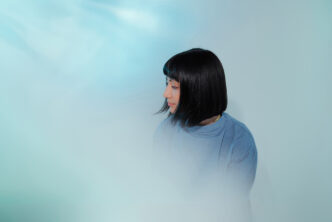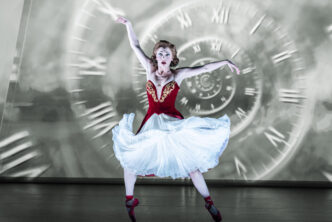Sir David Bintley’s Cinderella remains one of the most popular ballets in BRB’s repertoire. As the company prepares to take this magical production on tour again in 2025, Diane Parkes talks to designer John Macfarlane to find out what it takes to create Cinderella’s fairytale world on stage.
Artist and stage designer John Macfarlane has created stunning sets for shows across the globe but there was one story he really wanted to work on – Prokofiev’s ballet Cinderella.
So when former Birmingham Royal Ballet Director David Bintley decided to create a new production of Cinderella for 2010, John was delighted to be given the task.
“Cinderella was the one I wanted to do,” he recalls. “It’s always attracted me because of the music. For such a well-known story, the music is very dark and I think most artists and designers are always more inspired by something dark and magical. With Cinderella there’s so much for you to play with.”
John had worked with BRB in 1990 designing the iconic sets for the company’s production of The Nutcracker – a show which is greatly loved and still wows audiences most Christmases. But this was the first time he had collaborated with David Bintley.
“When David asked me to do Cinderella I was delighted, not just to work on Cinderella but also to work with him. That was the one chance we got to work together.
“I think in a sense the best experiences you have are when the person who is asking you to do something is on the same wavelength as you are. Then the discussion is quite minimal because you both want the same thing. He wanted to bring out the dark side as well and seemed very easy with what I was doing.”
A gift from David to Birmingham to celebrate the 20th anniversary of BRB’s move to the city, Cinderella premiered at Birmingham Hippodrome in November 2010 where it received critical acclaim and thrilled audiences.
With Cinderella being such a familiar story, the production needed to give audiences a tale they recognized but also provide plenty of suspense and surprises.
“My starting point is always ‘don’t make it too pretty.’ None of these big classic ballets are lovely cuddly stories,” John explains.
“The contrast in Cinderella’s circumstances is absolutely critical to the ballet. You have to believe in the first scenes of Cinderella to then see the contrast. There’s very little light music in that first scene with her in the kitchen so it should be like there’s no hope for her.
“If you don’t feel that then you don’t get this lovely moment when suddenly the fire pops out and something clearly magical is going to happen. If something magical doesn’t happen at that point you are going to shortchange your audiences as the audience is going to be coming in asking how is she going to the ball, how will the ball end, how will they do the clock?”

John’s transformation scene from ash girl Cinderella to belle of the ball is indeed magical – not least as the lizards, frogs and mice of the kitchen become her attendants.
“I was going to do lizard footmen whether anyone wanted them or not because I absolutely love designing characters with animal heads,” laughs John. “In Cinderella it is really important that you have this world that the Fairy Godmother builds. She takes the little critters from the kitchen, as Disney and many people before him did, and she turns them into coachmen and pages and all the magical things that take Cinderella to the ball.”
John painstakingly ensured the creatures were accurately portrayed. “It’s like when I did the rats for Nutcracker,” he says. “You have to be anatomically correct and they have to look real so I did about four or five sheets of detailed drawings of lizards.
“As soon as they are beautifully made you believe in them completely – and the quirk in it is that the lizards are wearing baroque costumes with coats and tails and shirt fronts.”
When Cinderella arrives at the ball she brings the magic with her.
“The ballroom is very normal and then she appears and it opens up and it’s the night sky. That was always something I thought would be wonderful,” says John.
“And then of course the clock needed to be this terrifying moment when the whole thing falls apart. You can absolutely hear the clock in the music. That’s the wonderful thing about Prokofiev and also Tchaikovsky – you can always tell where you’re going.
“When you start working on something like Cinderella, you’ve got to really listen to the music. Prokofiev gives you lots of leads before the clock starts that great whirring of the mechanism in the same way that Tchaikovsky gives you lots of leads before Aurora gets her finger pricked in the garden in Sleeping Beauty.”

John has designed numerous works including Swan Lake and Sir Peter Wright’s Giselle for Royal Ballet, War and Peace for Opéra Bastille, Hansel and Gretel and Queen of Spades for Welsh National Opera and a host of productions for New York’s Metropolitan Opera including The Flying Dutchman and Tosca.
“I only really do a show once and I only do ballet and opera because the music is so critical for me. I’m an avid reader and yet I get nothing when I read a script. If it’s an opera or ballet then everything is informed by the music.
“I have this belief that every production from Elektra to Don Giovanni to Tosca, they all have these critical moments, some of them the audience are hugely aware of, some of them are hopefully a huge surprise, but they all have this path through.”
Creating the right setting for the tale also ensures the audience enters the world onstage and becomes captivated by the story.
“All those huge Prokofiev and Tchaikovsky ballets have great stories and as long as you keep the story central it will work. And you hopefully don’t let the audience expectation down.
“So with Cinderella at midnight you’ve got to really show the audience that all this wonderful dream ballroom scene and meeting the prince have suddenly gone at the stroke of the clock. Cinderella is back to square one.”
The production also has plenty of comedy not least in the Stepsisters who are hideously mean but also so outrageous they create their own humour.
“We wanted the Ugly Sisters to be cruel of course and not just slapstick and funny,” says John. “David was brilliant on that with this sort of creepy quirky choreography for them.”
And the production needed to finish not just with a fairy tale happy ending but also with a grand finale which reflected Prokofiev’s great score.
“I think the end of Cinderella is one of the most beautiful pieces of music Prokofiev ever wrote. And so we have the Fairy Godmother and the sun coming up and the stars. There’s a magic to it as they walk into sunset or sunrise.”
Birmingham Royal Ballet Cinderella is at Lowry, Salford from 6-8 March 2025. Following on from the UK tour, the production will then play at Tokyo’s Bunka Kaikan in Japan (27 – 29 June).





